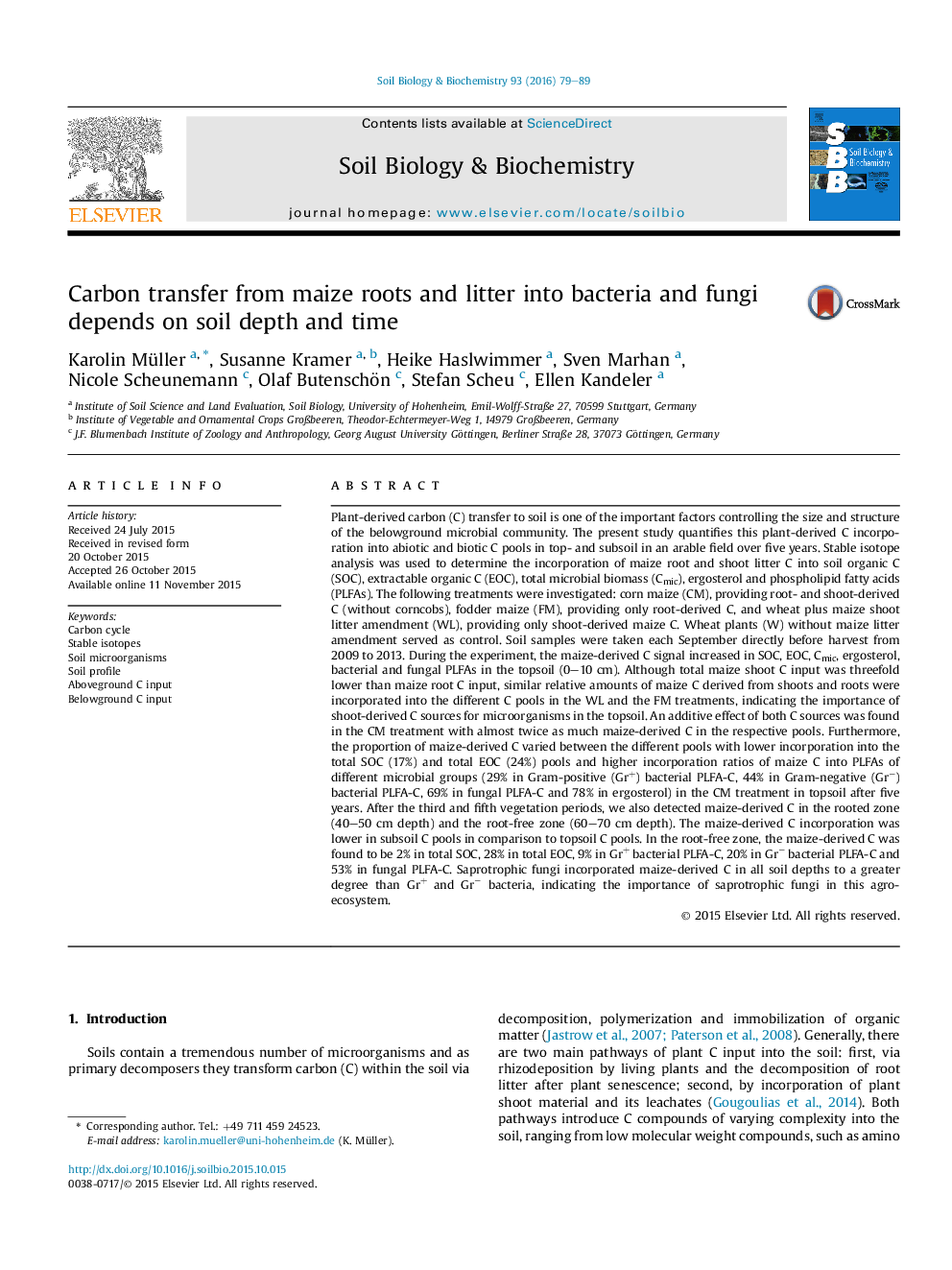| کد مقاله | کد نشریه | سال انتشار | مقاله انگلیسی | نسخه تمام متن |
|---|---|---|---|---|
| 2024247 | 1542591 | 2016 | 11 صفحه PDF | دانلود رایگان |
عنوان انگلیسی مقاله ISI
Carbon transfer from maize roots and litter into bacteria and fungi depends on soil depth and time
ترجمه فارسی عنوان
انتقال کربن از ریشه های ذرت و بستر به باکتری ها و قارچ ها بستگی به عمق و زمان خاک دارد
دانلود مقاله + سفارش ترجمه
دانلود مقاله ISI انگلیسی
رایگان برای ایرانیان
کلمات کلیدی
موضوعات مرتبط
علوم زیستی و بیوفناوری
علوم کشاورزی و بیولوژیک
دانش خاک شناسی
چکیده انگلیسی
Plant-derived carbon (C) transfer to soil is one of the important factors controlling the size and structure of the belowground microbial community. The present study quantifies this plant-derived C incorporation into abiotic and biotic C pools in top- and subsoil in an arable field over five years. Stable isotope analysis was used to determine the incorporation of maize root and shoot litter C into soil organic C (SOC), extractable organic C (EOC), total microbial biomass (Cmic), ergosterol and phospholipid fatty acids (PLFAs). The following treatments were investigated: corn maize (CM), providing root- and shoot-derived C (without corncobs), fodder maize (FM), providing only root-derived C, and wheat plus maize shoot litter amendment (WL), providing only shoot-derived maize C. Wheat plants (W) without maize litter amendment served as control. Soil samples were taken each September directly before harvest from 2009 to 2013. During the experiment, the maize-derived C signal increased in SOC, EOC, Cmic, ergosterol, bacterial and fungal PLFAs in the topsoil (0-10Â cm). Although total maize shoot C input was threefold lower than maize root C input, similar relative amounts of maize C derived from shoots and roots were incorporated into the different C pools in the WL and the FM treatments, indicating the importance of shoot-derived C sources for microorganisms in the topsoil. An additive effect of both C sources was found in the CM treatment with almost twice as much maize-derived C in the respective pools. Furthermore, the proportion of maize-derived C varied between the different pools with lower incorporation into the total SOC (17%) and total EOC (24%) pools and higher incorporation ratios of maize C into PLFAs of different microbial groups (29% in Gram-positive (Gr+) bacterial PLFA-C, 44% in Gram-negative (Grâ) bacterial PLFA-C, 69% in fungal PLFA-C and 78% in ergosterol) in the CM treatment in topsoil after five years. After the third and fifth vegetation periods, we also detected maize-derived C in the rooted zone (40-50Â cm depth) and the root-free zone (60-70Â cm depth). The maize-derived C incorporation was lower in subsoil C pools in comparison to topsoil C pools. In the root-free zone, the maize-derived C was found to be 2% in total SOC, 28% in total EOC, 9% in Gr+ bacterial PLFA-C, 20% in Grâ bacterial PLFA-C and 53% in fungal PLFA-C. Saprotrophic fungi incorporated maize-derived C in all soil depths to a greater degree than Gr+ and Grâ bacteria, indicating the importance of saprotrophic fungi in this agro-ecosystem.
ناشر
Database: Elsevier - ScienceDirect (ساینس دایرکت)
Journal: Soil Biology and Biochemistry - Volume 93, February 2016, Pages 79-89
Journal: Soil Biology and Biochemistry - Volume 93, February 2016, Pages 79-89
نویسندگان
Karolin Müller, Susanne Kramer, Heike Haslwimmer, Sven Marhan, Nicole Scheunemann, Olaf Butenschön, Stefan Scheu, Ellen Kandeler,
